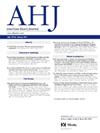Differences in Heart Rate Variability between Non-ST-Elevation Myocardial Infarction Patients with and without Type 2 Diabetes Mellitus
IF 3.7
2区 医学
Q1 CARDIAC & CARDIOVASCULAR SYSTEMS
引用次数: 0
Abstract
Background: Variations in heart rate variability (HRV), indicative of potential life-threatening conditions, are associated with an increased risk of ventricular arrhythmias and sudden death. Patients with myocardial infarction (MI) and type 2 diabetes mellitus (T2DM) may also exhibit significant changes in HRV markers that are commonly associated with unfavorable outcomes.
Objective: We evaluated the differences in HRV features between Non-ST-elevation MI (NSTEMI) patients with and without T2DM.
Methods: This study included 88 individuals diagnosed with NSTEMI, with an average age of 58 years. The participants were divided into two groups: Group I, 39 patients with T2DM (59% men) and Group II, 49 patients without DM (53% men). The Myocard-Holter-2 device was used for 24-hour Holter monitoring from to 10-14 days of hospitalization. This study evaluated the daily mean HR and transient HRV markers, including SDNN, SDNNi, rMSSD, and pNN50.
Results: The two groups were similar in terms of sex and age (p=0.312 and p=0.338, respectively). Patients with T2DM had a higher average daily HR of 82±9/min compared to 75±8/min (p=0.002). Patients in group 1 had lower average values for all HRV time parameters, including SDNN (87.2±18.1 ms vs 89.2±10.6 ms, p=0.006), SDNNi (27.5±5.1 ms vs 43.7±6.3 ms, p=0.004), rMSSD (21.4±3.2 ms vs 19.8±2.6 ms, p<0.001), and pNN50 (6.2±2.8% vs 5.3±2.4%, p<0.001).
Conclusions: Patients with NSTEMI and T2DM had lower HRV scores, suggesting that they may be at a higher risk for developing non-life-threatening cardiac arrhythmias and experiencing cardiac autonomic neuropathy.
求助全文
约1分钟内获得全文
求助全文
来源期刊

American heart journal
医学-心血管系统
CiteScore
8.20
自引率
2.10%
发文量
214
审稿时长
38 days
期刊介绍:
The American Heart Journal will consider for publication suitable articles on topics pertaining to the broad discipline of cardiovascular disease. Our goal is to provide the reader primary investigation, scholarly review, and opinion concerning the practice of cardiovascular medicine. We especially encourage submission of 3 types of reports that are not frequently seen in cardiovascular journals: negative clinical studies, reports on study designs, and studies involving the organization of medical care. The Journal does not accept individual case reports or original articles involving bench laboratory or animal research.
 求助内容:
求助内容: 应助结果提醒方式:
应助结果提醒方式:


